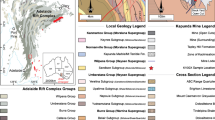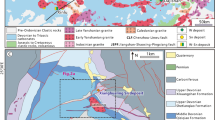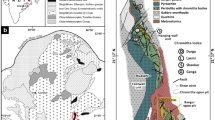Abstract
The Panasqueira W-Sn deposit is the largest quartz-vein type deposit of the Iberian Peninsula and the most important wolframite deposit in Western Europe. The ore-veins are almost exclusively sub-horizontal. Besides ore-bearing sub-horizontal veins, the Panasqueira mine also contains barren quartz veins. There are essentially two generations of barren quartz: quartz, contemporaneous with the earliest regional metamorphism (QI), and recrystallized quartz, contemporaneous with the thermal metamorphism related to the granite intrusion (QII). Fluid inclusion studies (microthermometry and Raman) were undertaken in order to distinguish fluids contemporaneous with the barren quartz from those contemporaneous with the ore-bearing quartz (QIII). Fluid inclusion data indicate that the barren and ore-bearing quartz fluids are dominantly aqueous (93 to 98 mol% H2O), with a nearly constant bulk salinity (8 to 12 wt% eq. NaCl), with the quantity of volatile component (determined by Raman spectrometry) higher in QIII, but never greater than 5 mol%. However, the CO2/CH4 + N2 ratio is different for each type of quartz. Volatiles are dominated by CH4 (10 to 96 mol% ZCH4 and/or N2 (3 to 87 mol% ZN2) in the barren quartz and by CO2 (60 to 73 mol% ZCO2) in ore-bearing quartz. The bulk chemical composition of the fluids in QIII is comparable to that found commonly in hydrothermal fluids associated with wolframite mineralization, where Na>K>Ca and HCO3>Cl>SO4. A dispersion in TH (226 to 350 °C) found in QIII, together with a variation in the degree of filling (0.5 to 0.7) and with the consequent variation of fluid densities (0.70 to 0.79), may result from changes in the fluid pressure regime below lithostatic pressure, suggesting vein filling related to tectonic events.
Similar content being viewed by others
References
Bussink, R.W. (1984) Geochemistry of the Panasqueira tungsten-tin deposit, Portugal. Geologica Ultraiectina, 33, 170 p. (Thesis)
Bussink, R.W., Kreulen, R., Jong, A.F.M. de (1984) Gas analyses, fluid inclusions and stable isotopes of the Panasqueira W-Sn deposits, Portugal. Bull. Minéral. 107:703–713
Clark, A.H. (1970) Potassium-argon ages and regional relationships of the Panasqueira tin-tungsten mineralization. Comun. Serv. Geol. Portg. 54:243–261
Charoy, B. (1979) Définition et importance des phénomènes deutériques et des fluides associés dans les granites. Conséquences métallogéniques. Sci. Terre, Fr., Mém. 37:364 p.
Derré, C., Lécolle, M., Roger, G., Carvalho, J.T.F. (1986) Tectonics, magmatism, hydrothermalism and sets of flat joints locally filled by Sn-W aplite-pegmatite and quartz veins; southeastern border of the Serra de Estrela granitic massif (Beira Baixa, Portugal). Ore Geol. Rev. 1:43–56
Dubessy, J., Ramboz, C. (1986) The history of organic nitrogen from early diagenesis to amphibolite fades: mineralogical, chemical, mechanical and isotopic consequences. Vth International Symposium on Water-Rock Interaction. Reykjavik, Iceland. Extended abstracts 171–174
Dubessy, I, Ramboz, C., Nguyen-Trung, C., Cathelineau, M., Charoy, B., Cuney, M., Leroy, J., Poty, B., Weisbrod, A. (1987) Physical and chemical controls (fO2, T, pH) of the opposite behaviour of U and Sn-W as exemplified by hydrothermal deposits in France and Great Britain, and solubility data. Bull. Minéral. 110:261–281
Dubessy, J., Poty, B., Ramboz, C. (1989) Advances in C-O-H-N-S fluid geochemistry based on micro-Raman spectrometric analysis of fluid inclusions. Eur. J. Mineral. 1:517–534
Eugster, H.P., Wilson, G.A. (1985) Transport and deposition of ore-forming elements in hydrothermal systems associated with granites. In: High heat production (HHP) granites, hydrothermal circulation and ore genesis. The Inst. Min. Metal. 87–98
Herzberg, G. (1951) Molecular spectra and molecular structure. II. Infrared and Raman spectra. Van Nostrand Reinhold Company
Kelly, W.C., Rye, R.O. (1979) Geologic, fluid inclusions and stable isotope studies of the tin-tungsten deposits of Panasqueira, Portugal. Econ. Geol. 74:1721–1822
Marignac, C. (1982) Geologic, fluid inclusions, and stable isotope studies of the tin-tungsten deposits of Panasqueira, Portugal — A discussion. Econ. Geol. 77:1263–1266
Noronha, F. (1984) Caractéristiques physico-chimiques des fluids associés à la genèse du gisement de tungstène de Borralha (Nord Portugal). Bull. Minéral. 107:273–284
Polya, D. (1989) Chemistry of the main-stage ore-forming fluids of the Panasqueira W-Cu(Ag)-Sn Deposit, Portugal: Implications for models of ore genesis. Econ. Geol. 84:1134–1152
Poty, B., Stalder, H.A., Weisbrod, A. (1974) Fluid inclusion studies in quartz from fissures of western and Central Alps. Schweiz. Mineral. Petrogr. Mitt. 54:717–752
Poty, B., Leroy, J., Jachimowicz, L. (1976) Un nouvel appareil pour la mesure des températures sous le microscope: l'installation de microthermométrie Chaixmeca. Bull. Soc. Fr. Minéral. Cristallogr. 99:182–186
Priem, H.N.A., Den Tex, E. (1982) Tracing crustal evolution in the NW Iberian Peninsula through Rb-Sr and U-Pb systematics of Paleozoic granitoids: a review. Phys. Earth Planet. Inst. 35:121–130
Ramboz, C., Schnapper, D., Dubessy, J. (1985) The P-V-T-X-fO2 evolution of H2O-CO2CH4-bearing fluid in a wolframite vein: Reconstruction from fluid inclusion studies. Geochim. Cosmochim. Acta. 49:205–219
Ribeiro, A., Pereira, E. (1982) Controles paleogeográficos, petrológicos e estruturais na genese dos jazigos Portugueses de estanho e volfrâmio. Geonovas, 1, 3:23–31
Roedder, E. (1984) Fluid Inclusions. Reviews in Mineralogy, 12. Mineral. Soc. Am. 644 pp.
Smith, A. (1979) Mining at Panasqueira mine, Portugal. Trans. Inst. Min. Metall. 88:A108-A115
Snee, L.W., Sutter, J.F., Kelly, W.C. (1988) Thermochronology of economic mineral deposits: dating the stages of mineralization at Panasqueira, Portugal, by high-precision 40Ar/39Ar age spectrum techniques on muscovite. Econ. Geol. 83:335–354
Sushchevskaya, T.M. (1976) Interpretation of chemical analyses of the liquid phase of inclusions in minerals. Geochem. Internat. 13, 1:78–81
Thadeu, D. (1951) Geologia do couto mineiro da Panasqueira. Comun. Serv. Geol. Portg. 32:5–64
Thadeu, D. (1977) Hercynian paragenetic units of the Portuguese part of the Hesperic Massif. Bol. Soc. Geol. Portg. 20:247–276
Thadeu, D. (1979) Le gisement stanno-wolframifère de Panasqueira. (Portugal). Chron. Recherche Minière 450:35–42
Touret, J. (1977) The significance of fluid inclusions in metamorphic rocks. In: Fraser, D.G. (ed.) Thermodynamics in geology. Reidel Publishing Company, Dordrecht, pp. 203–227
Turpin, L., Ramboz, C., Sheppard, S.M.F. (1981) Chemical and isotopic evolution of the fluids in the Sn-W deposits of Panasqueira, Portugal. Terra Cognita, Spec. Issue, Ist EUG meeting, 42
Author information
Authors and Affiliations
Rights and permissions
About this article
Cite this article
Noronha, F., Doria, A., Dubessy, J. et al. Characterization and timing of the different types of fluids present in the barren and ore-veins of the W-Sn deposit of Panasqueira, Central Portugal. Mineral. Deposita 27, 72–79 (1992). https://doi.org/10.1007/BF00196084
Received:
Accepted:
Issue Date:
DOI: https://doi.org/10.1007/BF00196084




